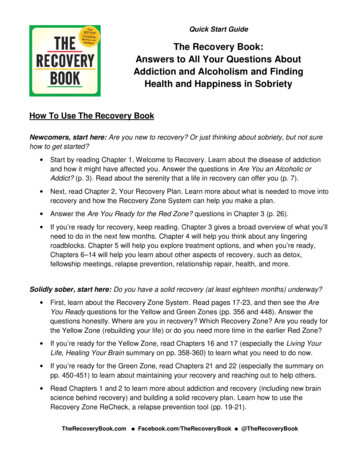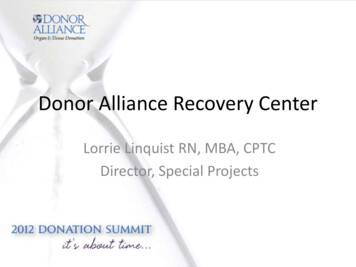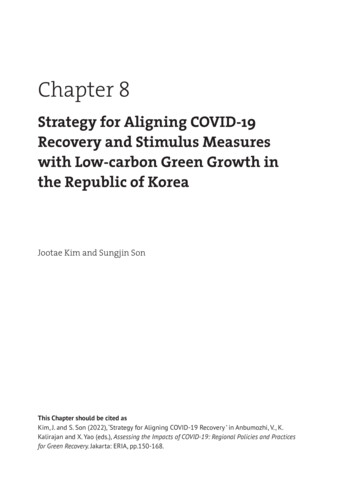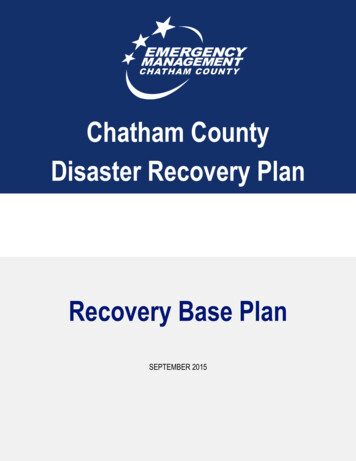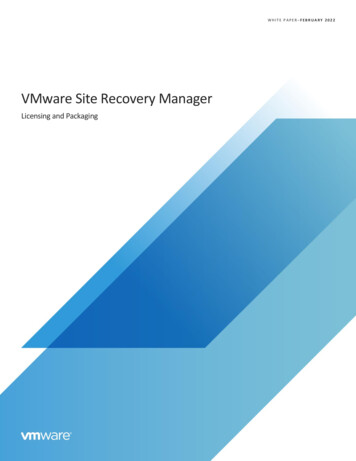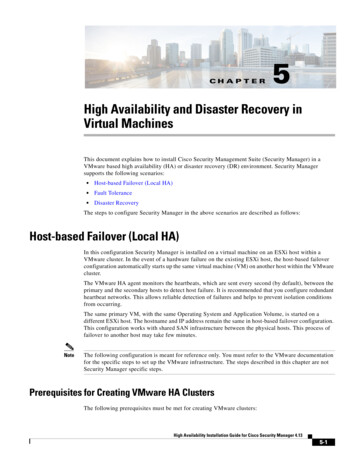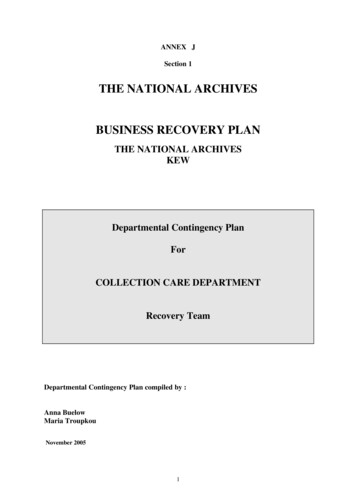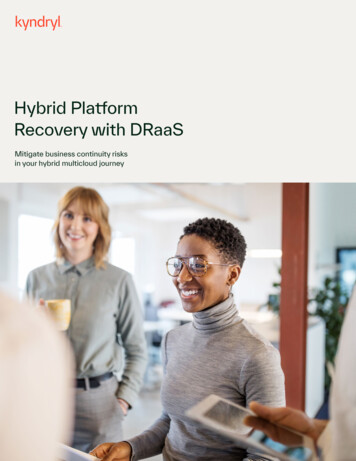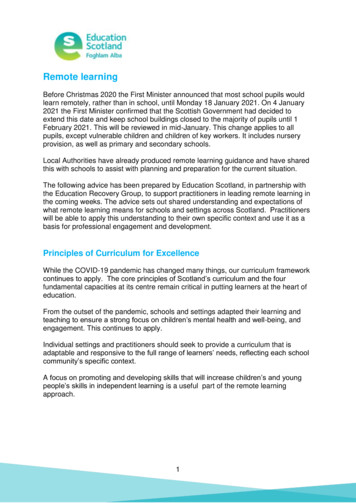
Transcription
Remote learningBefore Christmas 2020 the First Minister announced that most school pupils wouldlearn remotely, rather than in school, until Monday 18 January 2021. On 4 January2021 the First Minister confirmed that the Scottish Government had decided toextend this date and keep school buildings closed to the majority of pupils until 1February 2021. This will be reviewed in mid-January. This change applies to allpupils, except vulnerable children and children of key workers. It includes nurseryprovision, as well as primary and secondary schools.Local Authorities have already produced remote learning guidance and have sharedthis with schools to assist with planning and preparation for the current situation.The following advice has been prepared by Education Scotland, in partnership withthe Education Recovery Group, to support practitioners in leading remote learning inthe coming weeks. The advice sets out shared understanding and expectations ofwhat remote learning means for schools and settings across Scotland. Practitionerswill be able to apply this understanding to their own specific context and use it as abasis for professional engagement and development.Principles of Curriculum for ExcellenceWhile the COVID-19 pandemic has changed many things, our curriculum frameworkcontinues to apply. The core principles of Scotland’s curriculum and the fourfundamental capacities at its centre remain critical in putting learners at the heart ofeducation.From the outset of the pandemic, schools and settings adapted their learning andteaching to ensure a strong focus on children’s mental health and well-being, andengagement. This continues to apply.Individual settings and practitioners should seek to provide a curriculum that isadaptable and responsive to the full range of learners’ needs, reflecting each schoolcommunity’s specific context.A focus on promoting and developing skills that will increase children’s and youngpeople’s skills in independent learning is a useful part of the remote learningapproach.1
What is remote learning?Remote learning is learning that is directed by practitioners and undertaken bychildren and young people who are not physically with the practitioner whileinstruction is taking place.Remote learning involves a combination of ‘live’ interactions between teacher andlearners, and also learning which takes place away from the direct presence of theclass teacher. It may involve a range of learning experiences which take place in avariety of learning spaces, including outdoors and includes active and physicallearning.Whilst remote learning is not a substitute for full time classroom based learning andteaching, effective remote learning can mitigate some of the adverse impact of areduction in face-to-face learning and can offer learners: significant autonomy over their learninga degree of flexibility for learners in where and when they learnpotential for high quality consolidation of learningopportunities to develop and improve their skills in working independentlyincreased opportunities for personalisation in learningopportunities for improved engagementenhanced parental engagement in their child’s learning away from school.Remote learning can be delivered in a variety of ways. It may include reading, doing,creating and inventing, playing, problem solving, observing and investigating withsome of the best learning examples not requiring technology at all, although in thecurrent context, digital and online approaches will be commonly used.Learners should not engage in online learning for the entirety of the school day.Learning may include activities such as research tasks, project work, practicalopportunities, discussions and other activities that can be carried out away from adigital device.It is expected that learning will include provision of opportunities to consolidate,extend and enhance learning to take account of and meet the needs of learners andtheir families. This may be accommodated by providing access to pre-recordedlessons, presentations, lesson notes, diagrams or links to useful websites.School leaders have an important role in ensuring that all learners experience highquality learning experiences.The involvement of a further range of partners, including community and third sectororganisations to support remote provision has the potential to provide rich and variedlearning experiences.2
Key principles for remote learning include: remote learning will not replicate face to face in school teaching – in style,approach or hours of deliveryclass teacher retains responsibility for planning and organising children’s andyoung people’s learning, with learning supported by parents and carersopportunities for learners to progress and extend their learningapproaches to assessment of learning and providing feedback that supportand capture children’s and young people’s achievements in school and athomeprovision of learning activities to ensure engagement for all, considering theage and stage of development of learners, and introducing increasingopportunities for independent study as appropriateprovision of learning activities for learners who require additional support forlearning and any learners who may be particularly vulnerable ordisadvantageda shared understanding between home and school of the remote learningapproach and the respective roles and responsibilities of all involvedcontinued endeavours to tackle digital exclusion, including the provision ofdevices and connectivity solutions to support learningpartnership working with community providers and third sector organisationsto support provision.In line with these key principles, children and young people are entitled to: learning opportunities which reflect the principles of Curriculum forExcellence, allowing learners to develop their knowledge, skills and attributesin a variety of relevant contexts and across curriculum areasaccess to appropriate physical resources where needed – this might includelearning materials, textbooks and / or digital deviceson-line resources that will be consistently used across learning to aidinteraction, assessment and feedbackregular high quality interactive learning and teaching using technology orother remote methodsa balance of live learning and independent activityaccess to key learning which is available for learners to revisit as often asnecessaryongoing dialogue, reflection and feedback with practitioners in relation to theirown learningdaily registration/check in for every learner, recognising that the format for thismay vary depending on the age and stage of learnersregular opportunities for engagement with other pupils to support learning, aswell as informal engagementdue regard for their well-being and safeguarding.3
Support for remote learningEducation Scotland has curated into a single list all the support that is available onremote learning from national organisations. You can access the list of supportusing this link.Education Scotland and other bodies are working continuously to further improve thenational remote learning offer and support available to you. As these becomeavailable, they will be included on the page which can be accessed through theabove link.The support available is summarised below.The National e-Learning OfferThe National e-Learning (NeLO) programme has been set up by the National eLearning Partnership: Education Scotland, Scottish Government, the Association ofDirectors of Education (ADES) and eSgoil to support remote learning. All partnersare working together to deliver a single offer that builds coherently on what is alreadyavailable from schools, local authorities and Regional Improvement Collaboratives(RIC). This offer is initially bringing together the live learning option from e-Sgoil,recorded content led by the West Partnership through the West Online School teamand supported materials identified by practitioner networks and organised byEducation Scotland.The NeLO provides support for practitioners and learners in planning for remotelearning and has the following objectives: Practitioners will be able to use the national e-learning offer, when needed, tocomplement and enhance e-learning support available locally and within the localauthority and RIC to ensure that impact on a pupils’ education is minimised Practitioners will be able to access a range of resources to use in their owndelivery of remote learning. Schools will be able to use the national e-learning offer after the pandemic forother reasons such as the increase in the scope of senior phase curricular choicesor to support pupils experiencing disrupted learning.4
learners using prerecorded learningsessions identified bytheir teacher orsourced themselvesexamples:examples:Through West OS poweredby ClickView, availablethrough Glow or the locallyagreed VLEMixed earners interactingwith teachers onlinerecordedliveThe three component parts of The National eLearning Offer:learners using a varietyof digital contentidentified by theirteacher or sourcedthemselvesexamples:Higher Biology PodcastBBC BitesizeRGC Revision sitesLiveFollowing a request from CERG in August 2020, e-Sgoil http://www.e-sgoil.com/ hasdeveloped a 3-18 offer for schools and centres to access as part of their remotelearning plans. Schools should refer to the eSgoil website to see what is currently onoffer.SupportedSupported resources are currently available for:BiologyChemistryHuman BiologyPhysicsMathematicsApplications of MathematicsComputingEnglishESOLGaelic (Learners)FrenchMandarin (simplified)GermanSpanishThese resources can be accessed through this single point of access.RecordedThis element provides pre-recorded lessons and linked activities with which youngpeople can engage. This is being coordinated through the West Online School.Access to West OS requires access to be available to ClickView, which is enabledon a per local authority basis once the appropriate agreements are in place.5
There is a tile in GLOW for these local authorities to access WestOS. There arecurrently approximately 500 videos, in various subjects, developed by teachers forpractitioners.Accessing the NeLOWhen practitioners are preparing lessons to support learners at home, they canaccess materials from both the Recorded and Supported links above to developtasks and learning activities and share with learners via Glow (or the locally agreedVirtual Learning Environment (VLE)) to enhance their learning experiences.For live sessions, practitioners and schools can contact e-Sgoil to arrange forlearners to sign up to support the learning being offered by the school.Additional sources of supportIn addition to the NeLO there are a number of other sources of support for remotelearning, including:Scotland LearnsA range of ideas and suggestions of activities to help parents, carers andpractitioners support learning at home.What Scotland LearnedExamples of innovative practice from learners, parents and educators in Scotlandduring the first lockdown period March to August 2020.COVID-19 Education RecoveryA single point of access to guidance and support for COVID-19 recovery. It includeskey advice from the Scottish Government's COVID-19 Education Recovery Group(CERG), and from sources approved by CERG.Strengthening Support for school staffProviding access to a new package of support to support the wellbeing of schoolstaff including support sessions and webinars, coaching and mentoring opportunitiesand enhanced support for recently qualified teachers.Professional LearningProviding access programmes of learning and a wide variety on online eventscovering a range of topics, including Curriculum support, DYW, ProfessionalLearning, Inclusion and data analysis.6
GlowGlow is Scotland’s nationally available digital platform. It provides free access for alllearners and teachers to online tools such as Microsoft Office 365, Google G-Suitefor Education and WordPress Blogs.Digilearn.scotProviding a range of strategies, tools and guidance to support learning and teachingremotely.SQASQA has a resource hub for the delivery of National Qualifications in 2021 whereteachers can get access to the latest information and resources to support thedelivery of qualifications this year.GTCSGTC Scotland has created and curated a variety of resources and advice to supportpractitioner health and wellbeing during the Covid-19 crisis.Advice for practitioners when planning remote learningThe Refreshed Narrative for Curriculum for Excellence is a practical tool that willsupport schools when planning for a remote learning approach with the fourcapacities remaining at the heart of learning. Focus on learning across literacy,numeracy and health and wellbeing will be a continued priority with increasinglearning experiences across the four contexts. Cross-curricular linked themes,interdisciplinary learning (IDL) and play-based approaches will enrich the curriculumand be a useful bridge between learning in different spaces.Helpful advice for planning online aspects of learning can be found in EducationScotland’s Delivering Learning and Teaching Online resource. As is always the case,the class teacher retains responsibility for planning, organising and deliveringchildren’s and young people’s learning. Remote learning places different demandson the class teacher. It is important that the class teacher is supported in aspects ofplanning and delivery by schools, local authorities, Regional ImprovementCollaboratives and national bodies. Practitioners can access professional learningsupport around digital learning and teaching via Education Scotland Digilearn.scot.The General Teaching Council for Scotland (GTCS) has published Engaging online:A guide for teachers which has been endorsed by the Teacher ProfessionalAssociations.7
Organising LearningA good starting point when planning for remote learning is to consider how you mightorganise learning in a typical classroom situation i.e. under ‘normal’ circumstances.Where, in a classroom setting, the practitioner is not working directly with a group oflearners, what sort of activities would be planned for them and how would these beorganised?More specifically: Which elements of learning should be delivered via ‘live learning’? Why?Which aspects of learning would be best suited to take place independently,rather than online? Why?What resources are available locally and nationally to support remote learning?Are there activities and learning that can be done prior to face-to-face sessionsto help learners become familiar with the topic or concepts, using a flippedclassroom approach? Are there activities and learning that can take place afterthe face-to-sessions to deepen understanding, reinforce and consolidatelearning? How can we ensure learners, parents/carers and other professionalsknow what is expected in learning beyond the school?What resources can be provided that will help learners to revisit, apply anddeepen their learning?Can carefully planned inter-disciplinary learning challenges engage learners andenrich learning experiences?When considering the above it will be important to ensure activities are appropriateto the age and stage of learners. Realising the Ambition encourages practitioners toconsider learning spaces, interactions and experiences. The same considerationscan be helpful when planning learning for older learners.Personalised LearningJust as in classroom learning, activities, support and resources to be used awayfrom the school setting should be differentiated to meet the needs of learners.Where these offer the opportunity to build on, extend and apply previous classroomlearning, this is likely to be more successful.Challenges of remote learningEffective use of remote learning offers both challenges and opportunities forpractitioners, learners and parents.8
Practitioners may only be able to work on a ‘live’ basis with a proportion of the classat any one time. Given this commitment to ‘live’ learning, time for practitioners todevelop other aspects of remote learning is an important consideration.We need to be mindful of the impact of COVID-19 on our children and young people,many of whom may have suffered loss and trauma as a result. For all learners a keyfocus during this period of remote learning needs to be health and wellbeing. It willbe essential that remote learning approaches reflect this.It is important that, given the limited time with learners, a didactic teaching modeldoes not become the norm. Practitioners should have access to professionallearning opportunities which support them to understand and provide remotelearning methodologies to ensure they are well equipped to support children’s andyoung people’s learning and achievements.The move to remote learning may have a detrimental impact on progress in learningfor some learners. Attention will need to be given to those learners who facedisadvantage. Schools will need to carefully consider any steps which they can taketo mitigate barriers to learning and engagement.Practitioners will need to consider how they will plan most effectively for both the‘live’ teaching and learning which they will deliver online and the learning that willtake place remotely. Learners will need to adapt to these new circumstances whichmay require them to complete tasks prior to working directly with their teacher aswell as following these interactions.Parents and carers and remote learningParents and carers want the very best for their children. It is important to stress that,in a period of remote learning, parents and carers are not expected to be teachersand we understand that many will be juggling work and childcare. It is crucial thatparents and carers are as certain as they can be about what remote learning is, whatit means for their children and how they can continue to contribute positively andeffectively to their children’s learning. Good communication between home andschool is essential. Parents and carers should receive information from the localauthority and school regarding the plans they are putting in place, including accessto online learning so they and their children know what to expect.ConclusionWhat constituted high quality learning, teaching and assessment prior to thepandemic and what constitutes high quality learning, teaching and assessment nowhas not changed. The professionalism of our workforce remains. We all remain9
committed to children’s rights and positive relationships. We want our learners to beeager participants in their learning. Learning should be motivating, meaningful andenjoyable. It should also be well matched to children’s and young people’s needsand interests. It still remains important that learners understand the purpose of theirlearning and that assessment remains integral to learning and teaching.What has changed is the way in which we are seeking to attain high qualityexperiences for our learners. It is vital that we continue to adjust and tailor ourapproaches to help ensure the very best for all of our learners.The aim of everyone across Scottish education is that all learners can return toschool buildings as soon as it is safe to do so. As we work towards this it is importantto recognise the challenges of remote learning and how we address these. We alsoneed to acknowledge that the challenges differ across stages and sectors.It is important that we continue to build on the strong culture of collaboration thatexists across Scotland, strengthening this to ensure there are opportunities forschools, local authorities, Regional Improvement Collaboratives and national bodiesto work together to support remote learning.10
during the first lockdown period March to August 2020. COVID-19 Education Recovery A single point of access to guidance and support for COVID-19 recovery. It includes key advice from the Scottish Government's COVID-19 Education Recovery Group (CERG), and from sources approved by CERG. Strengthening Support for school staff


